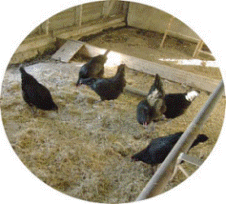


Having Fun With Nature
Raising Chickens
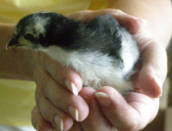

Copyright © Red Gate Farm 2012. All rights reserved.
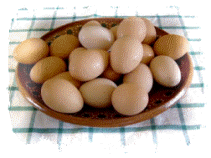
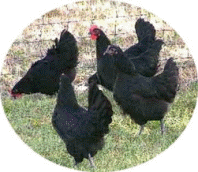
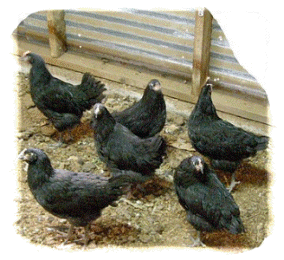
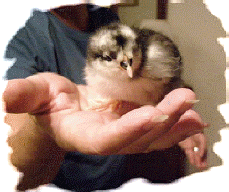

Chickens in Your Backyard: A Beginner's Guide
Rick & Gail Luttmann
Choosing and Keeping Chickens
Chris Graham
Suggested Reading
Deciding what breed to have can be either very interesting or very daunting. There are several good books on poultrty, as well as web sites. Some are listed in the boxes to the right.
Please consider the size, temperature tolerance, and purpose of your chickens. We have Black Australorps, a cross between a Buff Orpington and an Australian breed, because they are heat tolerant, sturdy, good layers, and cute as the dickens!
Outside coop
will clean your yard and pasture of bugs, but will drive you crazy with their constant chatter! There are show breeds like Silkies that are kept more as pets than for eggs (they actually need a bath now and then...ever try to bathe a chicken?)
Do your homework and decide on a breed you like, and that will like the conditions it will live under. A bit of reading really pays off in the long run!
Getting you chicks is a happy day for the chicken owner. If they are coming through the mail, find out when they'll be shipped and notify your post office. They'll let you know as soon as the chicks arrive so you can pick them up and they won't spend the day in a postal truck. Of course, if you live close to a breeder, you can pick them up yourself, check the order, and commune with them all the way home. When you get your chickens home you can read the instruction sheet that came with them, and you're on your way!
Be sure to get your chicks from a reputable poultry dealer. That way you will get healthy chicks from inspected premises. When you buy from a flea market or an online site such as Craig's List, there's no telling what you'll get. You don't need diseased birds! For the same reason, don't accept that Easter chick that your friend doesn't want any longer. Anyway, your established flock won't be too pleased with the interloper.
Black Australorps
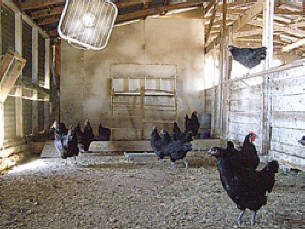

10 Day Old Chick
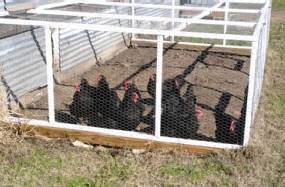

Young Ladies on the Earth Side of the Coop
The inside coop needs to be roofed and enclosed to keep out the elements and also a bottom barrier (we have chicken wire 12 inches deep with bricks on top the wire) to keep predators from digging in. The coop should also have good air circulation without being drafty.
The outside coop needs to be covered with chicken wire on the sides and top to keep out the predators.
The fan in the photo above gets turned on when the coop temperature reaches 90°F. In the winter, the girls get a heat lamp turned on when the temperatures drop into the 20's.
Chickens like to roost at night so a high beam or closet rod that will accomodate your flock is necessary.
Nest boxes need to be in the coop with a bedding of straw, hay, wood shavings, or shredded paper as nesting material. Our chickens love fresh wood shavings: they spend most of the day tossing it out!
Finally, the coop needs to be cleaned, as you would after a dog. Twice a year the bedding needs to be removed and replaced with hay, grass clippings, straw, etc. Our coop's floor is divided into 2 areas: one is bare earth so the ladies can dust bathe and the other part has 5-6" of grass clippings. Food and water is on the earth side so they don't get grass in the containers...just earth.
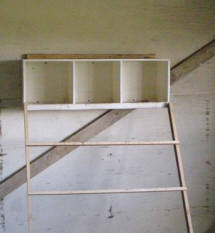

Half of the Inside coop. Note the fan for air circulation
Food and Water are obviously important to the well being of the birds. Chicks are fed "starter feed" for 17 weeks and then move on to layer feed, if they're kept for eggs. Even if you free range your chickens, they will still need some commercial feed to provide the medication, minerals, and vitamins necessary for good health.
We give the ladies treats of cooked rice, cooked pasta, left over salad, but never chocolate, spiced foods, raw onions, or garlic. Their digestive system cannot handle those foods.
Chickens are BIG drinkers. We have a 3 gallon dog waterer andf it gets filled twice a week for 7 chickens. Now that we have more chickens, it gets filled more frequently.
Of course, you'll water chicks from a shallow container so they don't drown. You have to clean and fill it more frequently, but the extra effort is worth it to have healthy chicks.
We collect rainwater for the ladies, but if you use tap water be sure to let it sit for 24 hours to dissipate the chemicals.
Nest boxes, approximately 1 foot square
Laying hens are fairly long lived. They start laying at 9-10 months old and continue to frequently lay until they are 3 to 4 years old. After that they will give an occasional egg.
Roosters are not necessary to get eggs. If you're in the suburbs or have close neighbors, the rooster crowing can be an irritant. Also some roosters are aggressive and will run you out of the coop.
Some say a rooster is a great addition to the flock, he's protective of his harem, beautiful, and cares tenderly for his ladies by giving them treats he has found and breaking up squabbles.
To have a rooster or not is your decision.
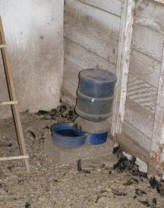

3 gallon Waterer
Ladies with Grass Clippings
